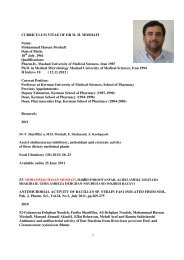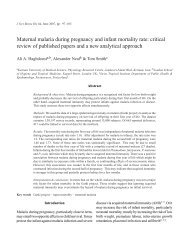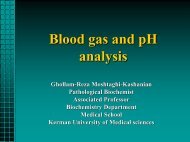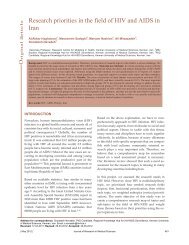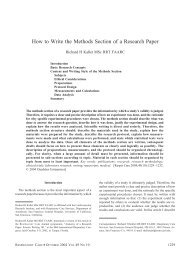Introduction to biochemistry.pdf
Introduction to biochemistry.pdf
Introduction to biochemistry.pdf
Create successful ePaper yourself
Turn your PDF publications into a flip-book with our unique Google optimized e-Paper software.
<strong>Introduction</strong> <strong>to</strong> <strong>biochemistry</strong><br />
Moshtaghi-Kashanian<br />
Associated professor<br />
Kerman University of Medical Sciences
What is Biochemistry<br />
Biochemistry is mother of different field in medicine<br />
1. Ana<strong>to</strong>my<br />
2. Physiology<br />
3. Pharmacology<br />
4. Genetic<br />
5. Immunology<br />
6. Bacteriology<br />
7. Immunology<br />
8. Parasi<strong>to</strong>logy<br />
1. Internal medicine<br />
2. Surgery<br />
3. Endocrinology<br />
4. Dentistry<br />
5. Psychology<br />
6. Sociology<br />
7. Nursing
Definition of Biochemistry<br />
“Chemistry of Life”<br />
Living Things are composed of lifeless molecules<br />
Doesn’t fully take in<strong>to</strong> account what chemistry is<br />
Biochemistry- Study of the structure, properties and<br />
changes of bio-matter
Special Considerations<br />
1. Complex and highly ordered<br />
2. Everything has a function<br />
3. Living things transform their environment<br />
(extract energy)<br />
4. Self-replicating<br />
5. Reactions occur at constant temperature,<br />
pressure and pH; in an aqueous environment
Biomolecules - Elements<br />
C, H, O, N 99% of mass of most cells<br />
P, S<br />
Mg 2+ , Na + , K + , Ca 2+ , Cl -<br />
Fe, Zn, Mn, Co, Cu
Biomolecules - Macromolecules<br />
1. Carbohydrates- made up mostly of 7<br />
monosaccharides<br />
2. Proteins - 5 × 10 6 , made up of 20 amino acids<br />
3. Nucleic Acids - 1,000, made up of 4 nucleotides<br />
4. Lipids
Water<br />
• 70% of most organisms<br />
• polar<br />
• favors solubility<br />
• directionality holds macromolecules in given<br />
conformations
Water<br />
• hydrogen bond<br />
• half-life < 1/1,000,000 sec<br />
• holds water <strong>to</strong>gether without being viscous<br />
• high specific heat<br />
• colligative properties<br />
• weakly ionizable
Sizes of living things
Cell Structure
Cell Membrane<br />
• Appears as 3 layers by EM<br />
• 7.5-10 nm thick<br />
• “Unit membrane”<br />
These three things are explained on<br />
a molecular level as a<br />
phospholipid bilayer<br />
Function: osmotic barrier<br />
Present in all cells<br />
Further consideration in lipid<br />
material.
Nucleus<br />
• Bounded by a porous<br />
nuclear membrane<br />
Function: contain DNA<br />
Present in all eukaryotic<br />
cells<br />
• 1 per cell<br />
• Often 1-4 nucleoli
The nucleus and the nuclear envelope
Cell Wall & cell membrane<br />
Thick, <strong>to</strong>ugh wall<br />
Function: rigidity<br />
Present in plant and prokaryotic cells
Animal cell ana<strong>to</strong>my
Plant cell ana<strong>to</strong>my
Mi<strong>to</strong>chondria<br />
• Shape varies, size varies<br />
• 500-2,000 per cell
Mi<strong>to</strong>chondria<br />
Function: “powerhouse of the cell”<br />
Present in all eukaryotic cells<br />
Structure: compartments<br />
Further consideration in metabolism.
Endoplasmic Reticulum<br />
Rough and Smooth<br />
Phospholipid bilayer surrounding a lumen ± ribosomes<br />
Function: protein synthesis (rough) lipid synthesis (smooth)<br />
Present in all eukaryotic cells (lots)
Rough Endoplasmic Reticulum<br />
Surface looks rough because of the presence of ribosomes,<br />
another organelle (present in all cells)
Golgi Apparatus<br />
His<strong>to</strong>rically cis, medial and<br />
trans: trans-golgi network<br />
Function: protein processing<br />
and secretion<br />
Present in all eukaryotic cells<br />
(lots)
Lysosomes<br />
• About as big as a<br />
mi<strong>to</strong>chondrion<br />
• not much <strong>to</strong> see<br />
Function: degradation of<br />
proteins<br />
Present in animal cells, plant<br />
cells have similar organelle<br />
called peroxisome<br />
Number per cell varies<br />
enormously
Chloroplasts<br />
• Stacks of “grana”<br />
• grana composed of<br />
thylakoid disks<br />
Function: pho<strong>to</strong>synthesis<br />
Present in pho<strong>to</strong>synthetic<br />
cells<br />
50-200 per cell
Cy<strong>to</strong>plasm<br />
Aqueous, solute-containing contents within the plasma<br />
membrane<br />
Contains soluble proteins, salts, organelles<br />
Cy<strong>to</strong>sol- is the supernate of a centrifugation process
Microtubules<br />
• Polymer of a protein called actin<br />
• Gives shape <strong>to</strong> cell, also functions in transport<br />
around the cell
4 classes of macromolecules<br />
Carbohydrates: Energy,<br />
structure<br />
Lipids: Energy, membranes<br />
Proteins:<br />
etc.<br />
Catalysts, structure,<br />
Nucleic Acids: Information
Macromolecules: Carbohydrates<br />
Glucose isomers
Macromolecules: Carbohydrates<br />
Carbohydrates
Polymerization<br />
glucose fruc<strong>to</strong>se sucrose
Making & breaking polymers
S<strong>to</strong>rage polysaccharides<br />
starch<br />
glycogen
Cellulose: A structural polysaccharide
Chitin: a structural polysaccharide
Fatty acids &<br />
triacylglycerol
Cholesterol:<br />
a steroid
Polar & charged amino acids
Nonpolar amino acids
Macromolecules: Proteins
Structural proteins
Protein Structure: 4 Levels<br />
Primary<br />
Secondary<br />
Tertiary<br />
Quaternary
lysozyme<br />
Primary structure of protein:<br />
the amino acid sequence
Amino Acid Structure<br />
R is different for different amino acids.
Polymerization<br />
is peptide bond<br />
formation
lysozyme<br />
Primary structure of protein:<br />
the amino acid sequence<br />
Primary structure is due <strong>to</strong> strong<br />
covalent peptide bonds joining amino<br />
acids <strong>to</strong>gether.
lysozyme<br />
Secondary structure:<br />
group of amino acids<br />
folded repetitively <strong>to</strong><br />
make a discrete shape.
lysozyme<br />
Secondary structure:<br />
group of amino acids<br />
folded repetitively <strong>to</strong><br />
make a discrete shape.<br />
due <strong>to</strong> hydrogen<br />
bonds between<br />
amino acids’<br />
backbones.
lysozyme<br />
Tertiary<br />
structure:<br />
the overall 3-d<br />
conformation of<br />
a polypeptide.
Tertiary<br />
structure<br />
involves several<br />
kinds of bonds.
Tertiary Structure<br />
Most proteins are<br />
hydrophilic outside,<br />
hydrophobic inside.
Macromolecules: Nucleic Acids<br />
Deoxyribonucleic<br />
Acid
Nucleic Acids are Polymers
pH and Buffers
Water is Weakly Ionizable<br />
• 2 H 2 O OH – + H 3 O +<br />
• Weakly means this doesn’t happen often<br />
• [OH – ] = [H 3 O + ] = 1 × 10 -7 M,<br />
• [OH – ] × [H 3 O + ] = 1 × 10 -14 , the basis of the pH<br />
scale
Equilibrium Constants<br />
Mathematically Represent Degree of<br />
Dissociation<br />
Keq’ is used in <strong>biochemistry</strong> <strong>to</strong><br />
denote modified standard<br />
state.
pKa’ Values are Used <strong>to</strong> Describe<br />
Ionization of Acids<br />
• CH 3 COOH + H 2 O CH 3 COO – + H 3 O +<br />
• Keq’ =<br />
• Ka’ = 1.74 x 10 -5 =<br />
• pKa’ = 4.76
Graphical Determination of pKa’<br />
• The pKa’ is the pH at the<br />
point where buffering<br />
occurs
Buffers<br />
Buffer- a compound that does not allow the pH <strong>to</strong><br />
change even if acid or base is added <strong>to</strong> the system.<br />
Amphiprotic compounds are also good buffers.<br />
Amphiprotic compound- a compound that can act as<br />
a pro<strong>to</strong>n donor or as a pro<strong>to</strong>n accep<strong>to</strong>r.
The Henderson-Hasselbalch Equation<br />
is Used <strong>to</strong> Determine the pH of<br />
Buffered Solutions<br />
pH = pKa’ + log<br />
[A – ]<br />
[HA]<br />
or pH = pKa’ + log<br />
[salt]<br />
[acid]
When pH = pKa’, There is Equal<br />
Amounts of A – and HA<br />
• Proof on board
pH Problems<br />
What will the pH of a solution be if 0.1 mL of 6 M<br />
HCl is added <strong>to</strong> 100. mL of H 2 O<br />
What will the pH of a solution be if 0.1 mL of 6 M<br />
HCl is added <strong>to</strong> 100. mL of 1 M HEPES initially<br />
at pH 7.6<br />
What will the pH of a solution be if 0.1 mL of 6 M<br />
HCl is added <strong>to</strong> 100. mL of 50 mM HEPES<br />
initially at pH 7.6
Choosing a Buffer<br />
• pKa ± 0.5 pH units<br />
• ionic strength: use 50 or 100 mM<br />
• metal ion chelation, etc.



